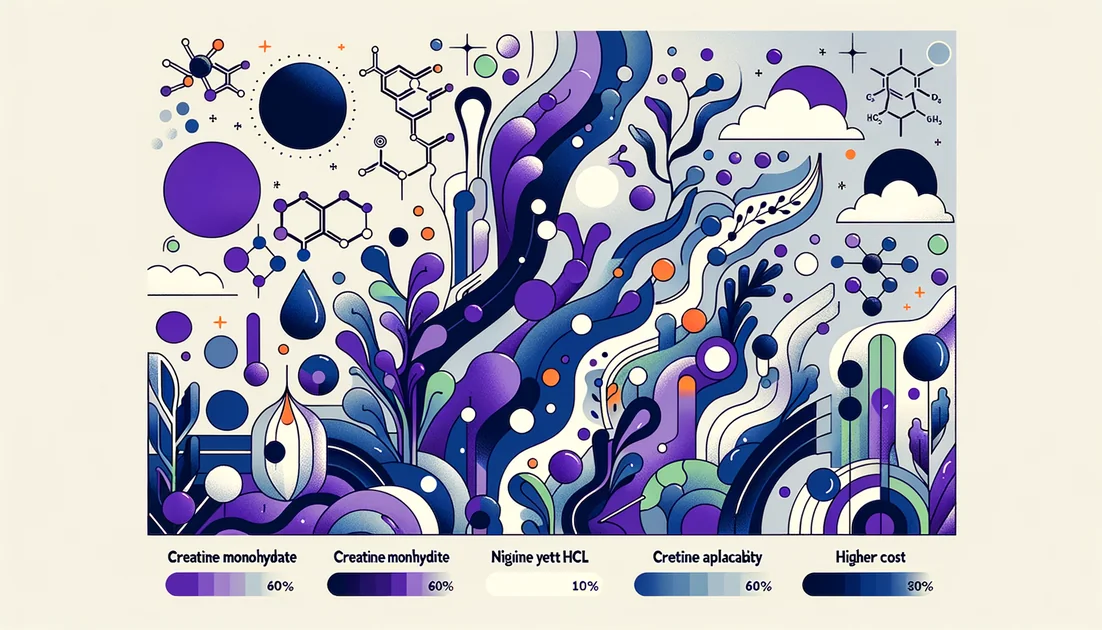
Alpha GPC + Uridine Monophosphate
Alpha GPC + Uridine: Can This Duo Build Better Synapses?
Quick Summary
- •The duo is a plausible dual-pathway stack (choline + uridine) with animal and mechanistic support
- •Direct Alpha GPC + UMP human data are lacking, so synergy is theoretical, not proven.
The Verdict
Dual CoreEssential Core: Alpha GPC, Uridine Monophosphate
Beneficial Additions: DHA (omega-3)
Optional Additions: B-vitamins (B6, B12, folate), Vitamin E, Selenium
The Synergy Hypothesis
Supplying choline (Alpha GPC) plus uridine (UMP) simultaneously fuels both sides of the phosphatidylcholine assembly line and nudges neurons toward growth, potentially yielding more synapses and steadier cholinergic signaling than either alone. Benefits likely deepen when DHA is present to furnish the right fatty acids for new membranes. [1][3][5][14]
How the system works →
Think of synapse building like a construction site. Alpha GPC delivers bricks (choline) for both acetylcholine messages and for wall material (phosphatidylcholine). Uridine flips on the site's power (UTP→CTP) that lets choline enter the line as CDP-choline, and also radios the crew via P2Y receptors to make scaffolding proteins and sprout new connections. Animal work shows uridine + choline (especially with DHA) increases brain phospholipids and synaptic proteins, and enhances learning; a medical food containing UMP + choline + DHA improved episodic memory in early Alzheimer's patients. But the two-item stack of Alpha GPC + UMP alone hasn't been put through A+B vs A vs B trials in humans yet. [1][3][4][14][15]
Solo vs Combination
Solo Alpha GPC can quickly boost acetylcholine, often felt as cleaner focus or memory cues; solo uridine tends to be slower, working on membrane precursors and subtle mood/energy changes. Together, you cover both the 'message' (acetylcholine) and the 'wiring' (membranes/synapses). The trade-off: the combo remains under-studied as a pair in humans, so expectations should be modest unless you also add DHA, where human data are stronger. [1][4][14]
The Ingredients
Alpha GPC +
primary active• essential
Delivers choline—the 'bricks' to make acetylcholine for signaling and phosphatidylcholine for cell membranes—so neurons can talk and build/repair synapses.
Works Alone?
Yes
Needs combination
- •Improves cognitive scores in mild impairment and may raise motivation in healthy adults
- •Raises the brain's choline/acetylcholine supply.
In This Combo
300–600 mg/day (often 300 mg AM ± 300 mg PM).
(dose-sparing effect)
Cost: $15–45/month (dose-dependent)
What if I skip this? (high impact, combo breaks)
- •You lose the main choline source, so acetylcholine signaling and membrane-building substrate drop
- •The stack becomes mostly a uridine-only play.
Uridine Monophosphate +
synergist• essential
Supplies the 'glue and go'—raises UTP/CTP that power the membrane-building step (CDP-choline) and nudges neurons to make synaptic proteins (via P2Y receptors).
Works Alone?
Yes
Needs combination
- •Short-term UMP can shift brain phosphorus metabolites linked to membrane synthesis
- •Animal/human pilot work suggests mood/cognition signals.
In This Combo
150–250 mg with Alpha GPC in the morning; optional second dose early afternoon.
(dose-sparing effect)
Cost: $10–25/month
What if I skip this? (moderate impact, combo survives)
- •Membrane construction is more limited because the 'energy currency' (CTP) for the CDP-choline step isn't boosted
- •You still get cholinergic effects from Alpha GPC.
How They Work Together
Alpha GPC + Uridine Monophosphate
dual pathway
- •Alpha GPC brings the 'bricks' (choline)
- •Uridine flips on the 'factory power' (CTP) and a growth signal so neurons can build more membrane and synapses.
In the Kennedy pathway, choline must join CTP (made from uridine) to form CDP-choline—the key ticket into phosphatidylcholine. Uridine also activates P2Y receptors, telling neurons to make synaptic proteins and sprout connections. Together this can mean more raw materials and more build signals at once.
- •In animals: +13–22% brain phosphatidylcholine with uridine+choline
- •~+45% when DHA is added. Human RCTs exist for the larger UMP+choline+DHA mix.
Alpha GPC → Choline pool → (needs) CTP; UMP → UTP/CTP → CDP-choline → Phosphatidylcholine → Synapses
Bricks + electricity for the construction site.
Alpha GPC + Uridine Monophosphate
spares dose
Uridine raises brain UTP→CTP and CDP-choline, the rate-limiting intermediate. Studies show uridine or cytidine can raise CDP-choline without lowering acetylcholine release, so you don't rob signaling to build membranes.
- •CDP-choline increased ~45% acutely in gerbil brain after UMP
- •Slices: +61–89% CDP-choline synthesis with uridine/cytidine.
UMP ↑ → UTP/CTP ↑ → CDP-choline ↑
Turning up the conveyor belt speed so more bricks reach the wall.
How the system works in detail →
Think of synapse building like a construction site. Alpha GPC delivers bricks (choline) for both acetylcholine messages and for wall material (phosphatidylcholine). Uridine flips on the site's power (UTP→CTP) that lets choline enter the line as CDP-choline, and also radios the crew via P2Y receptors to make scaffolding proteins and sprout new connections. Animal work shows uridine + choline (especially with DHA) increases brain phospholipids and synaptic proteins, and enhances learning; a medical food containing UMP + choline + DHA improved episodic memory in early Alzheimer's patients. But the two-item stack of Alpha GPC + UMP alone hasn't been put through A+B vs A vs B trials in humans yet. [1][3][4][14][15]
How to Take This Combination
Timing Protocol
- •Take both with breakfast
- •Optional second dose early afternoon if splitting. If adding DHA, take with a meal containing fat.
- •With food improves comfort and absorption
- •Earlier timing avoids occasional restlessness or sleep disruption some users notice with uridine.
Doses
Alpha GPC: 300–600 mg/day (often 300 mg AM ± 300 mg PM).
Uridine Monophosphate: 150–250 mg with Alpha GPC in the morning; optional second dose early afternoon.
Can add:DHA-rich omega-3 (1–1.5 g DHA/day), B-complex (as in medical foods), Magnesium (for general neuronal support)
Should avoid:Concurrent 5-fluorouracil/capecitabine chemotherapy (uridine can counteract drug action), High-dose overlapping cholinergics without supervision
The Evidence
- •No direct A+B vs A vs B clinical trials of Alpha GPC + UMP. Mechanistic and animal data show complementary roles
- •Multi-nutrient human trials with UMP+choline+DHA report benefits. Net: promising theory, not proven for this exact two-item stack.
0 combination studies — no direct combo studies 0 pharmacokinetic, 0 clinical, 6 mechanistic
View key study →
Closest human evidence: Fortasyn Connect (contains UMP + choline + DHA + cofactors) improved episodic memory in early Alzheimer's across RCTs; mechanistic human MRS shows it shifts brain phospholipid metabolism. [14]
- •Theorized to support both cholinergic transmission and synapse/membrane building
- •Strongest evidence emerges when DHA is added.
Read full technical summary →
Alpha GPC supplies choline for acetylcholine and membrane phosphatidylcholine; uridine (UMP) boosts the other half of the membrane-building pathway by raising UTP/CTP and nudging neurons to make synaptic proteins via P2Y receptors. In animals, uridine + choline (especially with DHA) increases brain phospholipids and synaptic markers and can improve learning; in early Alzheimer's, a larger multi-nutrient mix containing UMP + choline + DHA has human RCT support. But the exact two-ingredient combo (Alpha GPC + UMP) has not been tested head-to-head versus each alone in people. Consider this a thoughtful, mechanistically coherent stack—stronger with DHA—yet still a theory awaiting direct clinical proof. [1][3][4][5][14]
Cost
Estimated Monthly Cost
$25–70/month for the two-item stack (brand and dose dependent).
View breakdown →
Alpha GPC: $15–45/month (dose-dependent)
Uridine Monophosphate: $10–25/month
Money-saving options
- Citicoline alone (~$20–35/month)
- Add DHA only if budget allows to approach the evidence-backed triad
Alternative Approaches
UMP + Choline + DHA (Fortasyn-like core)
Uridine (as UMP), Choline source (Alpha GPC or choline bitartrate), DHA (1–1.2 g/day)
+Best human evidence for memory/synapse outcomes comes from this triad in medical-food RCTs.
−More pills; higher cost; effects shown mainly in early Alzheimer's, not guaranteed in healthy users.
Choose if:You want the version with the strongest clinical backbone and are okay adding DHA.
Citicoline (CDP-choline) + DHA
Citicoline 250–500 mg/day, DHA 1–1.5 g/day
+Citicoline delivers both choline and uridine (in humans) in one capsule; solid safety and cognition data; simpler.
−May feel less 'cholinergic punch' than Alpha GPC for some; still benefits most with DHA.
Choose if:You prefer one primary pill and evidence-based simplicity.
Alpha GPC solo (± DHA)
Alpha GPC 300–600 mg/day, Optional DHA 1 g/day
Safety Considerations
Alpha GPC is generally well-tolerated in trials, but a large Korean cohort linked long-term α-GPC prescriptions with higher 10-year stroke risk (association ≠ causation; confounding possible). Uridine is well-tolerated at supplement doses; plain uridine has low bioavailability, while triacetyluridine raises blood levels. Critically, uridine (as uridine triacetate) is an antidote for 5-FU/capecitabine toxicity—so avoid supplemental uridine if you receive these drugs. Start low, avoid bedtime dosing if alerting, and reassess after 4–8 weeks. [10][11][12][13][20]
⚠️ Contraindications
- ✗Patients on 5-fluorouracil or capecitabine (uridine can counteract chemotherapy) [20]
- ✗Individuals with high stroke/cardiovascular risk who prefer to avoid α-GPC until signals are clarified [11]
- ✗Pregnant/breastfeeding individuals (insufficient data for high-dose nootropic use)
- ✗Anyone with bipolar disorder starting uridine without medical guidance (mood-active history; pilot data are preliminary)
Common Misconceptions
- ✗"This combo is clinically proven." Reality: no A+B vs A vs B human trials yet.
- ✗"Alpha GPC is the only choline that reaches the brain." Other forms work; kinetics differ.
- ✗"Uridine always feels energizing right away." Its main role is membrane precursors; effects can be gradual.
- ✗"More choline is always better." Excess can cause headaches/low mood in some and may raise TMAO depending on form.
Common Questions
Has Alpha GPC + UMP been tested together in humans?
Do I need DHA with this combo?
What doses are typical?
- •Common practice: Alpha GPC 300–600 mg/day
- •UMP 150–300 mg/day, usually with breakfast. Start low for a week and adjust. Medical foods used ~625 mg/day UMP. [14]
How long until I notice anything?
Is it safe with my medications?
Interaction Network Details →
Alpha GPC:A choline donor that feeds acetylcholine and membrane building.
Uridine Monophosphate:Turns on the membrane factory and nudges synapse growth.
Brain choline pool:The stockpile of choline used for acetylcholine and membranes.
UTP/CTP supply:Energy-like nucleotides that let choline enter the build line.
CDP-choline step:The key ticket that combines choline with fats to form membranes.
Phosphatidylcholine synthesis:Making the main membrane lipid that builds synapses.
Synapse formation:Growing/repairing the 'plugs' where neurons talk.
Acetylcholine signaling:The memory messenger boosted by choline.
Memory & focus:Sharper recall and attention when signaling and wiring improve.
Visual network diagram coming in future update
You might also like
Explore more of our evidence-led investigations, comparisons, and guides across every article style.

Source Naturals
Veteran formulator with rigorous in-house testing—and a transparency gap

Creatine Monohydrate (CM) vs Creatine Hydrochloride (Cr-HCl)
For most people, choose Creatine Monohydrate for proven results, simple dosing, and best value. Consider Creatine HCL only if you consistently get GI upset from CM and are willing to pay more; it hasn't shown better outcomes in trials. [1][2][4][5]


Resveratrol
A TV segment in 1991 suggested the French owed their strong hearts to red wine. The world raised its glass. Yet the compound most blamed for the magic—resveratrol—exists in wine at whisper-levels, far below doses used in studies. So what does resveratrol really do, and for whom?


Tocotrienols
The stealthier cousins of vitamin E—built with springy tails that move differently in cell membranes and behave differently in your body.




